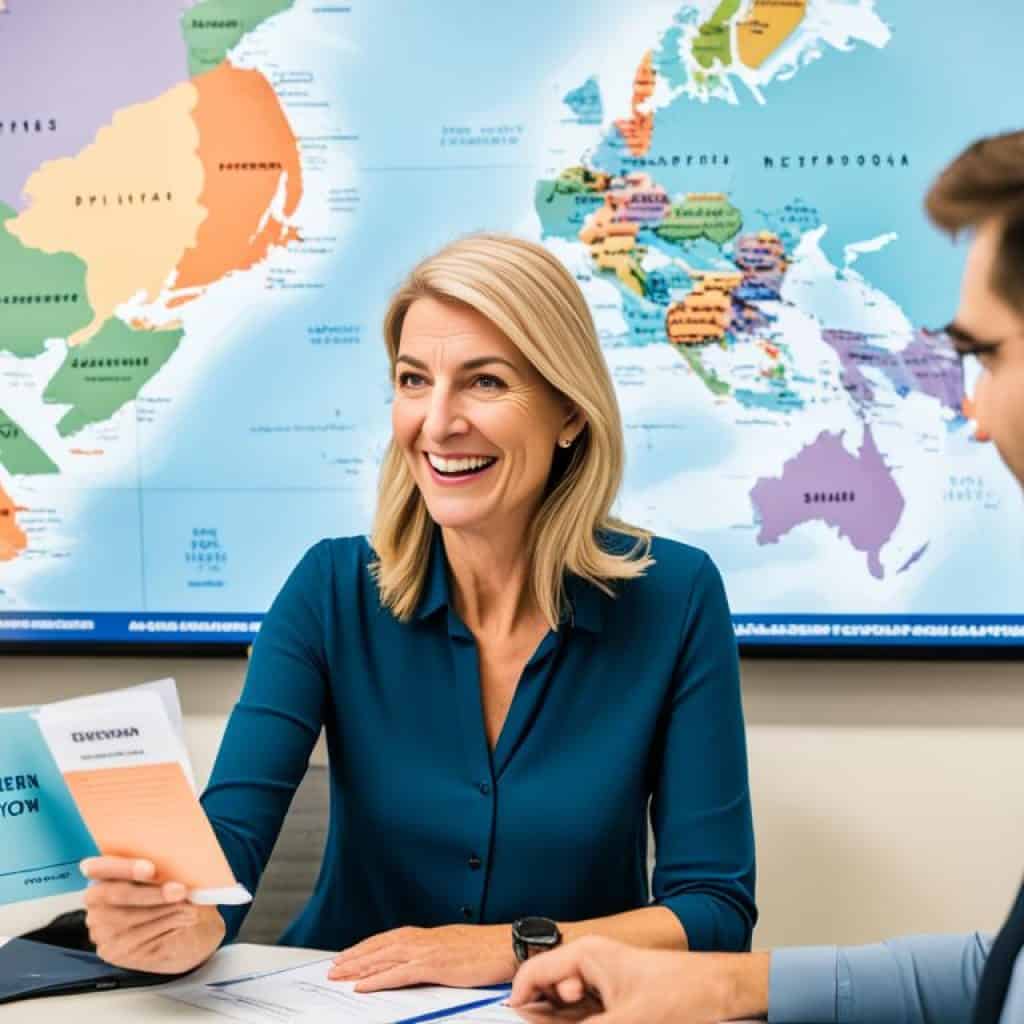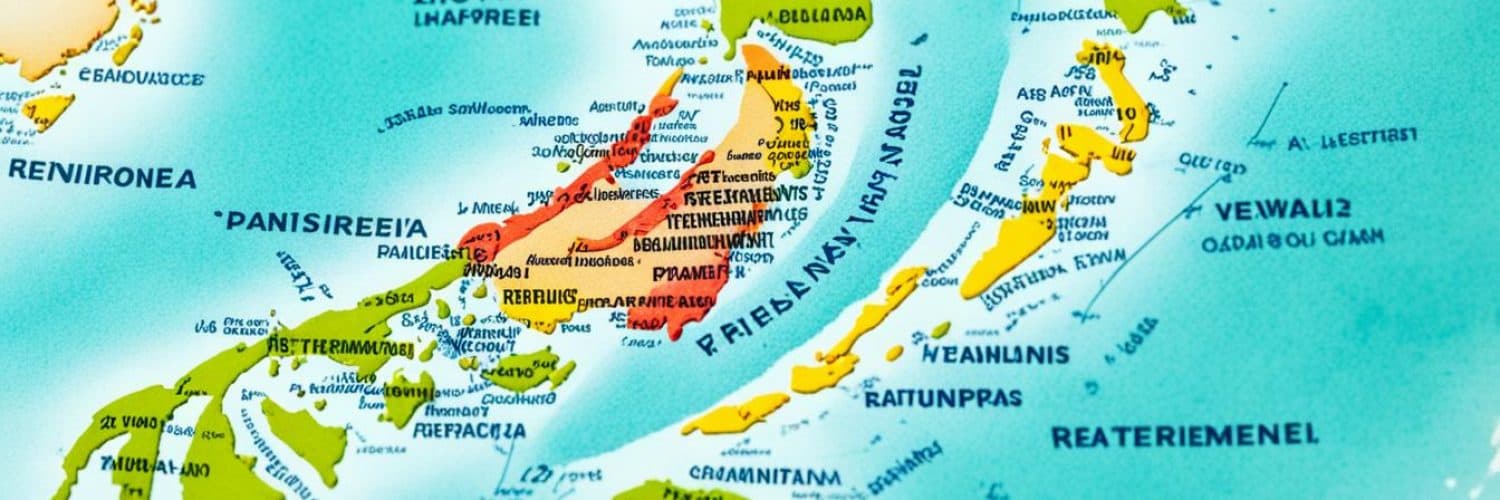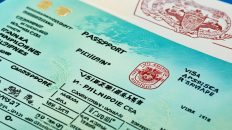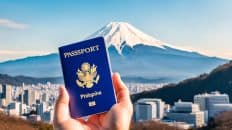Are you a US expat dreaming of sunny days, beautiful beaches, and a low cost of living? The Philippines is your ideal destination. With its welcoming policies and stunning views, it’s perfect for your retirement. However, it’s crucial to know how the retirement visa process works in this beautiful place.
Everything from application steps to the best visa options and retiring benefits in the Philippines is covered here. So, are you set to explore what it takes to retire in the Philippines and get a retirement visa?
Key Takeaways:
- Learn about the requirements and eligibility criteria for a retirement visa in the Philippines
- Explore the various retirement visa options available
- Discover the benefits and advantages of retiring in the Philippines
- Understand the application process and necessary documents
- Find out about the cost of living and healthcare options for retirees
Who Can Apply for a Philippines Retirement Visa?
If you’re looking to retire in the Philippines, there’s good news. The country has a retirement visa program named the Special Residence Retiree’s Visa (SRRV). This lets outsiders call the Philippines their new home and enjoy retirement in a tropical setting.
To apply for the SRRV, you must meet certain requirements. Let’s go through them.
- Age requirement: You must be at least 50 with a pension or 35 with a deposit of $50,000.
- Financial capability: You need to show you and any family with you can live comfortably in the Philippines.
- Criminal record: You must have a clean legal background, with no criminal convictions.
So, whether you have a pension or make a deposit, the retirement visa is a great way to enjoy the Philippines. It welcomes retirees warmly.
Many expats choose the Philippines for retirement for its low living costs, friendly people, and beautiful scenery. With the retirement visa, you can embrace your new life and the country’s rich culture and hospitality.
“Retiring is not the end of the road; it is the beginning of the open highway.”
You now know the eligibility for a Philippines retirement visa. Next, let’s look at the deposit needed to secure it.
Deposit for the Philippines Retirement Visa (SRRV)
Getting a Philippines retirement visa means making a deposit through the SRRV program. How much you need to deposit depends on your age and if you get a pension.
For those 50 or older with a pension, the deposit is $10,000. Single people must get at least $800 per month. Couples need $1,000 per month combined.
Bringing more than one child means paying an extra $15,000 for each one.
Without a pension, deposit amounts change with age. Here are the specific amounts needed:
| Applicant’s Age | Deposit Requirement |
|---|---|
| 35-49 years old | $50,000 |
| 50-59 years old | $75,000 |
| 60 years old and above | $100,000 |
Remember, deposit amounts can change. Check with the Philippine Retirement Authority (PRA) when you apply.
Additional Requirements for Dependent Children
If you’re bringing kids to the Philippines, you’ll need an extra deposit for each. The needed amounts are listed below:
| Number of Children | Deposit Amount per Child |
|---|---|
| 1 | $15,000 |
| 2 | $30,000 |
| 3 | $45,000 |
These deposits help make sure retirees can support themselves and their kids in the Philippines. The deposit stays valid as long as you keep your retirement status.
Documents Required for a Philippine Retirement Visa
When you apply for a Philippines retirement visa, you need these important documents:
1. Original and Valid Passport
Your passport should be valid. It must also have an up-to-date Temporary Visitor’s Visa.
2. Completed PRA Application Form
Make sure to fill out the PRA Application Form fully and accurately.
3. Medical Clearance
You need a medical clearance. It should certify your good health.
4. Clean Criminal Records
Show clean criminal records from your country. This proves your good character.
5. Photographs
Include your recent photos. They must meet the Philippine Retirement Authority (PRA)’s specs.
6. Inwardly Remitted SRR Visa Deposit and Proof of Payment
Send the needed inward remittance for the SRRV deposit. Also, show the payment proof.
7. Additional Documents
Some SRR Visa options might need extra documents. Get the details from the PRA.
All documents not in English must be translated. They also need authentication by the nearest Philippine Embassy or Consular Office.
Preparing these documents helps make your retirement visa application go smoothly.
How to Apply for a Retirement Visa in the Philippines?
Applying for a retirement visa in the Philippines for expats is simple. You must first join the SRRV Retirement Program. This lets retirees live and invest in the Philippines. You must carefully follow several important steps to apply.
Schedule an Appointment at the Philippine Retirement Authority
To start, book an appointment at the Philippine Retirement Authority (PRA). The PRA handles the approval of retirement visas. Visit their website or call them to schedule your appointment.
Choose the Appropriate Retirement Option
At the PRA, you’ll pick the best retirement visa option for you. The SRRV program has many options like SRRV Smile and SRRV Classic. Each has its own requirements and perks. It’s key to know each one before choosing.
Collect the Required Documents
After deciding on a visa option, collect all needed documents. These usually include:
- Current passport with a valid Temporary Visitor’s Visa
- Filled out PRA Application Form
- Medical clearance
- Clean criminal record from your home country
- Photos
- Proof of SRR visa deposit payment
- Extra documents based on your SRR Visa choice
Make sure all your documents are in English, or have them translated.
Submit the Application to the PRA
“Now, with your documents ready, submit your application to the PRA. Remember, you must do this in person at a PRA satellite office in the Philippines. They might ask for extra info or clarifications.”
After you submit, the PRA will review your application. If it’s approved, you get your retirement visa. You can then enjoy your retirement in the Philippines.
The retirement visa process can differ by individual situations and any changes in requirements. Always check the official PRA website or contact them for the latest info.

Retirement Visa Options in the Philippines
The Philippines has a special program for retirees called the Special Residence Retiree’s Visa (SRRV). It offers various options to fit different needs, lifestyles, and qualifications.
Let’s explore the main retirement visa options:
-
SRRV Smile
Perfect for active retirees, the SRRV Smile lets you live hassle-free. It’s great for those who want to explore and enjoy the Philippines’ beauty and culture.
-
SRRV Classic
The SRRV Classic is for those wanting to enjoy retirement and invest. It provides all benefits of the SRRV Smile, plus investment options in businesses, properties, or retirement plans.
-
SRRV Human Touch
For those with health concerns, the SRRV Human Touch is available. It gives you access to medical and healthcare services, ensuring care during retirement.
-
SRRV Courtesy
Former Filipino citizens and retirees from international organizations can choose SRRV Courtesy. It’s designed to welcome them back, offering benefits and privileges for a comfortable retirement.
-
SRRV Expanded Courtesy
Retired foreign military officers have the SRRV Expanded Courtesy option. This visa allows them to benefit from retired military privileges while enjoying life in the Philippines.
Among these, the SRRV Classic and SRRV Courtesy are very popular among expats. They make retiring in the Philippines an attractive choice.
Retirement Visa Application Fees
When applying for a Philippines Retirement Visa, you need to know about the fees. These fees are part of the total cost of getting a retirement visa in the Philippines.
The fees to apply for a retirement visa are:
- $1,400 for the main applicant
- $300 for dependent applicants
- An annual fee of $360 for the main applicant and two dependents
The fees mentioned might change based on the retirement visa you choose. Be sure to check the fees and requirements for the visa you want.
| Fee | Amount |
|---|---|
| Principal applicant | $1,400 |
| Dependent applicants | $300 |
| Annual fee for principal and two dependents | $360 |
These fees help cover the costs of processing your visa application. Remember to include these fees in your budget for retirement in the Philippines.
Understanding the fees is key to planning your retirement in the Philippines. Knowing them helps you prepare better financially.
Accompanying Family Members
Retiring in the Philippines lets you enjoy beautiful scenery and warm weather. It also lets you bring your loved ones with you. With a Philippines Retirement Visa, your family can join you in this exciting new chapter. Your spouse and children under 21 who are not married can come along.
If your spouse can’t join, don’t worry! You can bring two children without an extra deposit. This way, you can make great memories with your loved ones in the Philippines.
In the Philippines, you can explore beautiful beaches and dive into the vibrant culture. Or, you can just enjoy spending time with your family. The Philippines is a great place for retirees to make lasting memories with their loved ones.
The Benefits of Bringing Your Family
Bringing your family to the Philippines with a Retirement Visa is wonderful. You all can enjoy the country’s warmth and hospitality. Your children will learn about new cultures and make friends. They will see the country’s diverse wonders. Plus, having your spouse with you means you can face this adventure together. As a result, you’ll create a stronger bond and build unforgettable moments as a family.
Establishing a New Home as a Family
Starting a new home abroad is thrilling for the family. With a Philippines Retirement Visa, retirees enjoy all retirement benefits. They provide a safe and welcoming environment for their family. You’ll enjoy the local food and join cultural events. This offers your family many chances to dive into the Filipino culture and make memories for a lifetime.
Benefits of Philippines Retirement Visa
Retiring in the Philippines offers many advantages for visa holders. Some key benefits include:
- Visa holders can stay as long as they want with freedom to travel in and out.
- It simplifies the visa application process by waiving certain immigration rules.
- Moving is easier since you don’t pay customs duties and taxes on household goods.
- Retirees’ children can study in the Philippines without needing a student visa.
- There’s airport help for retirees, making arrivals and departures smoother.
- Retirees get a free PRA newsletter subscription, keeping them updated on retirement visa issues.
- There are special discounts at select merchants and shops for retirees.
- Retirees get help with government agencies, making paperwork less stressful.
- Retirees can access PhilHealth benefits, ensuring they have healthcare coverage.
The Philippines is an excellent choice for a rewarding retirement. These benefits aim to provide a comfortable and hassle-free lifestyle.

Duration of a Philippines Retirement Visa
The Philippines retirement visa, known as SRRV, offers the chance to stay indefinitely. It lets retirees live in the Philippines without limits. This visa also gives them permanent residence.
Retirement time is for rest and discovery. The Philippines is a great place for retirees. It has pretty beaches, a lively culture, and warm weather.
Benefits of the Retirement Visa:
- Multiple-entry visa, enabling retirees to travel in and out of the country conveniently.
- Indefinite stay with the freedom to choose the duration of residency.
- Opportunity to create a new home and immerse oneself in the vibrant Filipino culture.
- Access to a wide range of healthcare options, including the government-provided Philippine Health Insurance Corporation (PhilHealth) coverage.
Retirees can use this visa to follow their dreams. They might start a business, volunteer, or enjoy the beautiful scenery and relaxed pace of the Philippines.
“Retiring in the Philippines has been a dream come true for me. The retirement visa allows me to live here permanently, and I wake up every day to stunning views, friendly locals, and a welcoming community of expats like myself.” – Robert Smith, retiree in the Philippines
This retirement visa helps retirees enjoy everything the Philippines has to offer. It is a great option for American expats looking for a happy and affordable retirement.
| Retirement Visa Duration | Requirements |
|---|---|
| Indefinite stay | Valid retirement visa (SRRV) |
Cost of Living in the Philippines for Retirees
The Philippines offers a low cost of living. This makes it great for retirees. But, the needed money for a good retirement can change. It depends on where you live and your way of life.
A retiree might spend about $516 monthly, not including rent. This covers basic needs, getting around, food, and fun. Costs may vary, especially when comparing big cities like Makati to smaller places.
Living Costs in Big Cities vs. Smaller Cities
In big cities like Makati, living costs more. Rent, utilities, and daily spends can be higher. Yet, these places offer more amenities and things to do.
Smaller cities or rural areas are cheaper. Rent and everyday costs are lower here. These spots are also quieter, perfect for a peaceful retirement.
“Retiring in the Philippines can provide a great opportunity to enjoy a comfortable lifestyle at a fraction of the cost compared to many Western countries.”
Remember, the figures we talk about are averages. What you spend will depend on your own choices and lifestyle. Some may want a luxury life, while others go simpler.
In the end, retiring in the Philippines lets you enjoy more with your savings. You can have a quality life, beautiful places, and friendly people around.
| Expense | Big Cities (e.g., Makati, Quezon, Pasig) | Smaller Cities or Rural Areas |
|---|---|---|
| Rent | Higher | Lower |
| Utilities | Higher | Lower |
| Groceries | Similar | Similar |
| Transportation | Higher | Lower |
| Dining Out | Higher | Lower |
| Entertainment | Higher | Lower |
Table: Cost of Living Comparison in the Philippines
- Rent: Higher in big cities, lower in smaller cities or rural areas.
- Utilities: Higher in big cities, lower in smaller cities or rural areas.
- Groceries: Similar in both big cities and smaller areas.
- Transportation: Higher in big cities, lower in smaller cities or rural areas.
- Dining Out: Higher in big cities, lower in smaller cities or rural areas.
- Entertainment: Higher in big cities, lower in smaller cities or rural areas.
Healthcare for Retirees in the Philippines
Retirees in the Philippines can use Philippine Health Insurance Corporation (PhilHealth) for healthcare. PhilHealth offers full coverage, keeping retirees protected. This helps them enjoy their retirement years without worrying about health expenses.
Through PhilHealth, retirees get many healthcare services. They include:
- Inpatient and outpatient services
- Ancillary services
- Catastrophic coverage
- Maternity benefits
- Surgeries
Retirees don’t have to stress over medical bills with PhilHealth’s coverage. It covers treatments, hospital stays, and surgeries. PhilHealth takes care of retirees’ health, giving them peace of mind.
Retirees may also add private health insurance to PhilHealth. This private option offers more benefits, customized to what they need. It allows access to special medical services, more coverage, and more hospitals.
Many private health insurance plans are there for retirees in the Philippines. With these, retirees get even better healthcare services. Private health insurance acts as extra security. It ensures that retirees get the best care for their specific health needs.
Retirees in the Philippines can enjoy free healthcare with PhilHealth. The program has broad coverage, like inpatient and outpatient care, ancillary services, catastrophic coverage, maternity benefits, and surgeries. For more protection and perks, retirees can choose private health insurance too.
PhilHealth and private health insurance together give retirees in the Philippines great healthcare. They can get regular check-ups, special treatments, or emergency care. Retirees know their health is a priority in the Philippines.
Best Places to Retire in the Philippines
The Philippines is a great place for retirees, thanks to its low living costs. You can pick from luxury living, cool weather, amazing views, or a mix of city and countryside. There’s something here for everyone.
Makati City
Makati City lies at Manila’s core, offering a luxury lifestyle. It has fancy malls, top-notch restaurants, and lively nightlife. This city gives retirees the best of urban life. It also has cultural spots and beautiful parks for a full living experience.
Baguio City
Choose Baguio City for a cool climate. This city, in Luzon’s mountains, is the “Summer Capital of the Philippines.” Its mild weather, stunning views, and green areas offer a calm setting. Baguio has a tight-knit community and rich culture too.
Tagaytay City
Tagaytay City is perfect for those who love great views and food. It sits above Taal Volcano and Lake, offering amazing sights and cool weather. Known for its fresh, local dishes, it’s a food lover’s dream. This city combines nature’s beauty with tasty cuisine.
Lipa City
Lipa City brings together urban and rural life. In Batangas Province, this lively city has modern services, shops, and peaceful countryside views. It’s perfect for retirees who love city conveniences but also appreciate nature and community warmth.
Iloilo City
Iloilo City offers a peaceful, affordable way of life. This lovely city in Western Visayas has a deep history, beautiful colonial buildings, and a laid-back vibe. Retirees can check out historical sites, enjoy walks by the river, and try great local food.
Whether you’re into a luxury city life, cool climate, amazing views, urban-rural mix, or a quiet, cost-effective lifestyle, the Philippines has a spot for you. Its low living cost and friendly communities make it perfect for a happy, fulfilling retirement.
Conclusion
Retiring in the Philippines is a great choice for expats who love beautiful, tropical places with low living costs. The country has amazing beaches, warm weather, and friendly people. This makes for a relaxed and dreamy lifestyle for retirees.
The process to apply for a retirement visa in the Philippines is pretty simple. This makes it easy for expats to call this country their new home. There are many visa options for retirees depending on what they need and qualify for. So, everyone can find something that works for them.
Having a retirement visa in the Philippines comes with big perks. Expats get to have permanent residency, come and go as they please, skip some immigration steps, and use healthcare and other services. These benefits make the Philippines a top choice for retirees from the US looking for a happy and easy retirement.
FAQ
Who can apply for a Philippines Retirement Visa?
What is the deposit requirement for a Philippines Retirement Visa?
What documents are required for a Philippine Retirement Visa?
How do I apply for a Retirement Visa in the Philippines?
What are the retirement visa options in the Philippines?
How much are the retirement visa application fees?
FAQ
Who can apply for a Philippines Retirement Visa?
If you are 35 years old with ,000, you can apply. Also, if you’re 50 or older with a pension, you’re eligible for a Philippines Retirement Visa.
What is the deposit requirement for a Philippines Retirement Visa?
The deposit for the visa changes with age and pension. If you are 50 or older with a pension, you need ,000. Without a pension, the deposit varies by age.
What documents are required for a Philippine Retirement Visa?
You need to submit a few documents. This includes a valid passport, a PRA Application Form, and a medical clearance. You’ll also need clean criminal records, photos, proof of deposit, and some other documents based on the visa type.
How do I apply for a Retirement Visa in the Philippines?
First, sign up for the SRRV Retirement Program. Then, schedule a visit at the PRA and pick the right retirement option. Gather all necessary documents and submit them in person at a PRA office in the Philippines.
What are the retirement visa options in the Philippines?
The Philippines offers several retirement visas like SRRV Smile, SRRV Classic, SRRV Human Touch, SRRV Courtesy, and SRRV Expanded Courtesy. SRRV Classic and Courtesy are the favorites.
How much are the retirement visa application fees?
Application fees are
FAQ
Who can apply for a Philippines Retirement Visa?
If you are 35 years old with $50,000, you can apply. Also, if you’re 50 or older with a pension, you’re eligible for a Philippines Retirement Visa.
What is the deposit requirement for a Philippines Retirement Visa?
The deposit for the visa changes with age and pension. If you are 50 or older with a pension, you need $10,000. Without a pension, the deposit varies by age.
What documents are required for a Philippine Retirement Visa?
You need to submit a few documents. This includes a valid passport, a PRA Application Form, and a medical clearance. You’ll also need clean criminal records, photos, proof of deposit, and some other documents based on the visa type.
How do I apply for a Retirement Visa in the Philippines?
First, sign up for the SRRV Retirement Program. Then, schedule a visit at the PRA and pick the right retirement option. Gather all necessary documents and submit them in person at a PRA office in the Philippines.
What are the retirement visa options in the Philippines?
The Philippines offers several retirement visas like SRRV Smile, SRRV Classic, SRRV Human Touch, SRRV Courtesy, and SRRV Expanded Courtesy. SRRV Classic and Courtesy are the favorites.
How much are the retirement visa application fees?
Application fees are $1,400 for the main applicant and $300 for dependents. There’s also a yearly $360 fee for the main applicant and up to two dependents. Fees can change based on the retirement visa type chosen.
Can I bring my family members with my retirement visa?
Yes, your spouse and kids under 21 years old who are not married can join you. If your spouse isn’t coming, you can bring two children without paying extra.
What are the benefits of a Philippines Retirement Visa?
How long does a Philippines Retirement Visa last?
The visa grants permanent residence. This means you can live in the Philippines indefinitely.
What is the cost of living like for retirees in the Philippines?
Living in the Philippines costs less than many places. Retirees might spend about $516 monthly, not including rent. However, costs in cities like Makati, Quezon, or Pasig are more than in smaller cities.
What healthcare options are available for retirees in the Philippines?
Retirees can use free healthcare from PhilHealth. They also have the option of private health insurance for more benefits.
What are the best places to retire in the Philippines?
Great places for retirees include Makati City, Baguio City, Tagaytay City, Lipa City, and Iloilo City.
,400 for the main applicant and 0 for dependents. There’s also a yearly 0 fee for the main applicant and up to two dependents. Fees can change based on the retirement visa type chosen.
Can I bring my family members with my retirement visa?
Yes, your spouse and kids under 21 years old who are not married can join you. If your spouse isn’t coming, you can bring two children without paying extra.
What are the benefits of a Philippines Retirement Visa?
How long does a Philippines Retirement Visa last?
The visa grants permanent residence. This means you can live in the Philippines indefinitely.
What is the cost of living like for retirees in the Philippines?
Living in the Philippines costs less than many places. Retirees might spend about 6 monthly, not including rent. However, costs in cities like Makati, Quezon, or Pasig are more than in smaller cities.
What healthcare options are available for retirees in the Philippines?
Retirees can use free healthcare from PhilHealth. They also have the option of private health insurance for more benefits.
What are the best places to retire in the Philippines?
Great places for retirees include Makati City, Baguio City, Tagaytay City, Lipa City, and Iloilo City.


















Add comment